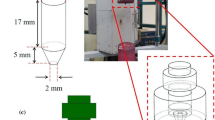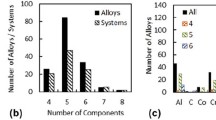Abstract
The evolution of the microstructure and mechanical properties of quasibinary Al–6.5Cu–2.3Y and Al–6Cu–4.05Er alloys during homogenization and subsequent thermomechanical treatment has been studied in this work. The Cu concentration in the aluminum solid solution increases during homogenization before quenching owing to the dissolution of a nonequilibrium excess of phases of crystallization origin and is 1.8 and 2.3% for the alloys containing Y and Er, respectively. The size of intermetallic phases in the Al–6.5Cu–2.3Y and Al–6Cu–4.05Er alloys homogenized at 605°С for 3 hours is 1.2 and 0.75 μm, respectively, and does not increase significantly with an increased annealing time. The Al–6Cu–4.05Er alloy is less prone to softening during annealing after rolling than the Y-containing alloy. This is explained by a greater degree of alloying of the aluminum solid solution (Al) and by a greater degree of dispersity of phases of crystallization origin. However, because of the same factor, the Er-containing alloy has a higher inclination to recrystallization and thereby a coarser recrystallized grain. As a result, the Al–6Cu–4.05Er alloy demonstrates higher mechanical tensile characteristics, especially after annealing at temperatures above 150°С.






Similar content being viewed by others
REFERENCES
GOST 1583-93. Casting Aluminum Alloys. Technical Conditions (IPK Izd-vo standartov, Minsk, 2000) [in Russian].
ASM Handbook.Properties and Selection: Nonferrous Alloys and Special-Purpose Materials.Vol. 2 (The Materials Information Company, 2010).
I. I. Novikov, Hot Brittleness of Nonferrous Metals and Alloys (Nauka, Moscow, 1966) [in Russian].
D. G. Eskin, Suyitno, and L. Katgerman, “Mechanical properties in the semi-solid state and hot tearing of aluminium alloys,” Prog. Mater. Sci. 49, 629–711 (2004).
V. S. Zolotorevskiy and A. V. Pozdniakov, “Determining the hot cracking index of Al–Si–Cu–Mg casting alloys calculated using the effective solidification range,” Int. J. Cast Met. Res. 27, 193–198 (2014).
V. S. Zolotorevskiy, A. V. Pozdniakov, and A. Yu. Churyumov, “Search for promising compositions for developing new multiphase casting alloys based on Al–Cu–Mg matrix using thermodynamic calculations and mathematic simulation,” Phys. Met. Metallogr. 113, 1052–1060 (2012).
A. V. Pozdniakov and R. Y. Barkov, “Microstructure and materials characterisation of the novel Al–Cu–Y alloy,” Mater. Sci. Technol. 34, 1489–1496 (2018).
A. V. Pozdnyakov, R. Y. Barkov, Z. Sarsenbaev, S. M. Amer, and A. S. Prosviryakov, “Evolution of microstructure and mechanical properties of a new Al–Cu–Er wrought alloy,” Phys. Met. Metallogr. 120, 614–619 (2019).
Y. Zhang, K. Gao, S. Wen, H. Huang, Z. Nie, and D. Zhou, “The study on the coarsening process and precipitation strengthening of Al3Er precipitate in Al–Er binary alloy,” J. Alloys Compd. 610, 27–34 (2014).
S. P. Wen, K. Y. Gao, Y. Li, H. Huang, and Z. R. Nie, “Synergetic effect of Er and Zr on the precipitation hardening of Al–Er–Zr alloy,” Scr. Mater. 65, 592–595 (2011).
S. P. Wen, K. Y. Gao, H. Huang, W. Wang, and Z. R. Nie, “Precipitation evolution in Al–Er–Zr alloys during aging at elevated temperature,” J. Alloys Compd. 574, 92–97 (2013).
A. V. Pozdniakov, R. Y. Barkov, A. S. Prosviryakov, A. Y. Churyumov, I. S. Golovin, and V. S. Zolotorevskiy, “Effect of Zr on the microstructure, recrystallization behavior, mechanical properties and electrical conductivity of the novel Al–Er–Y alloy,” J. Alloys Compd. 765, 1–6 (2018).
Y. Zhang, H. Gao, Y. Kuai, Y. Han, J. Wang, B. Sun, S. Gu, and W. You, “Effects of Y additions on the precipitation and recrystallization of Al–Zr alloys,” Mater. Charact. 86, 1–8 (2013).
Y. Zhang, J. Gu, Y. Tian, H. Gao, J. Wang, and B. Sun, “Microstructural evolution and mechanical property of Al–Zr and Al–Zr–Y alloys,” Mater. Sci. Eng., A 616, 132–140 (2014).
A. V. Pozdniakov, R. Yu. Barkov, S. M. Amer, V. S. Levchenko, A. D. Kotov, and A. V. Mikhaylovskaya, “Microstructure, mechanical properties and superplasticity of the Al–Cu–Y–Zr alloy,” Mater. Sci. Eng., A 758, 28–35 (2019).
Funding
The work was supported by the Russian Science Foundation (project no. 19-79-10242).
Author information
Authors and Affiliations
Corresponding author
Additional information
Translated by O. Golosova
Rights and permissions
About this article
Cite this article
Amer, S.M., Barkov, R.Y., Yakovtseva, O.A. et al. Comparative Analysis of Structure and Properties of Quasibinary Al–6.5Cu–2.3Y and Al–6Cu–4.05Er Alloys. Phys. Metals Metallogr. 121, 476–482 (2020). https://doi.org/10.1134/S0031918X20030023
Received:
Revised:
Accepted:
Published:
Issue Date:
DOI: https://doi.org/10.1134/S0031918X20030023




